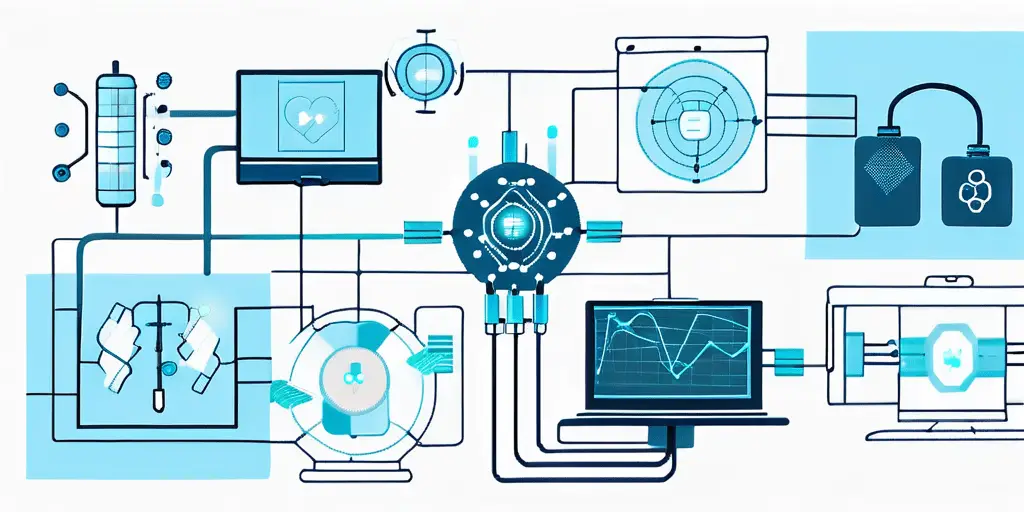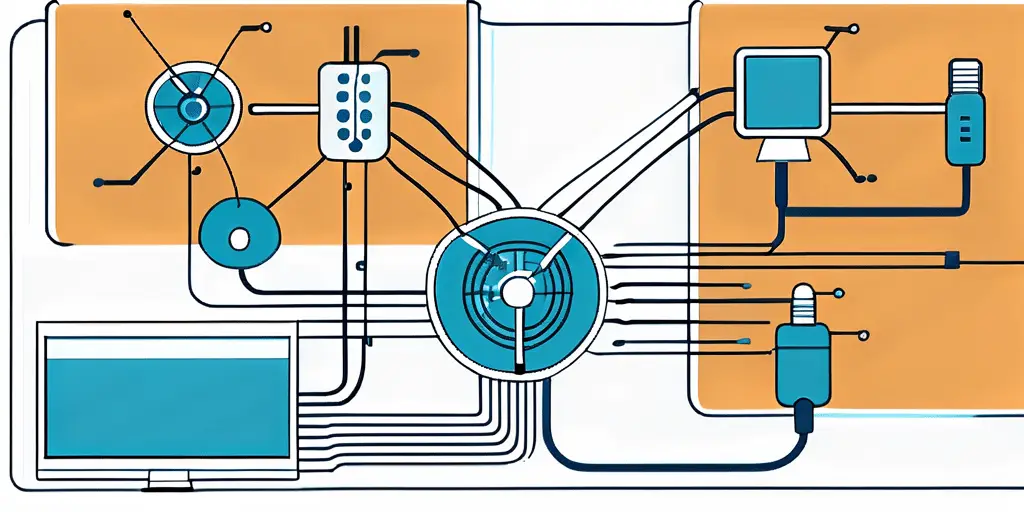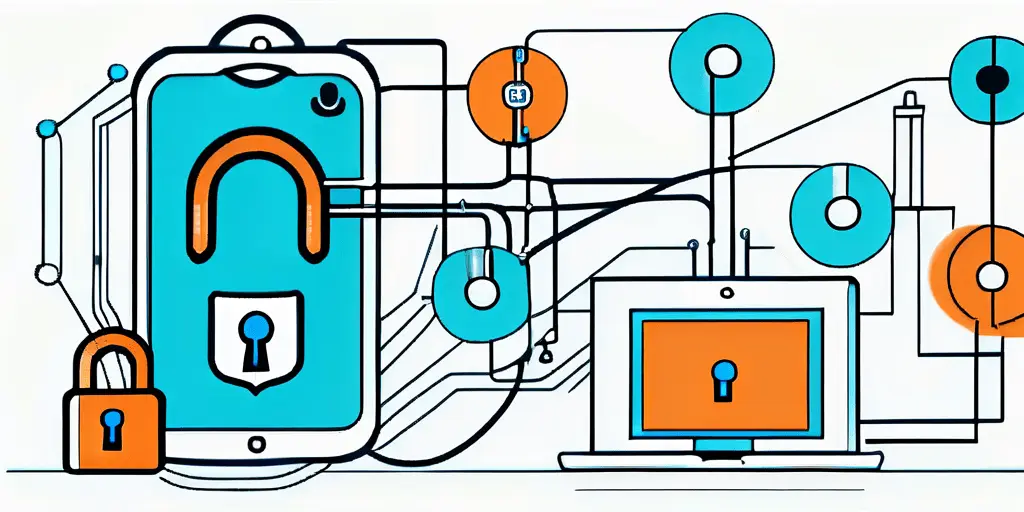Updated November 10, 2024
In today’s world, medical devices play a vital role in diagnosing and treating various health conditions. Technological advancements have interconnected these devices, enabling machine-to-machine (M2M) communication that enhances their capabilities. However, along with the benefits comes the risk of cybersecurity vulnerabilities.
Understanding M2M Communication in Medical Devices
Before we delve deeper into the vulnerabilities, let’s first grasp the concept of M2M communication in medical devices. Simply put, M2M communication refers to the exchange of information between devices without human intervention. In the context of healthcare, this communication happens between medical devices to improve patient care, data collection, and diagnostics.

Expanding on the concept of M2M communication in medical devices, it is crucial to highlight the intricate network of sensors, actuators, and communication protocols that enable seamless data exchange. These devices work harmoniously to collect and transmit vital information, creating a web of interconnected healthcare technologies that support medical professionals in delivering personalized and efficient patient care.
The Role of M2M Communication in Healthcare
M2M communication has revolutionized the healthcare industry by enabling real-time monitoring and remote patient care. It allows doctors and healthcare providers to access critical data and make informed decisions promptly. Whether transmitting vital signs from wearable devices or sharing medical records across healthcare systems, M2M communication has undoubtedly enhanced the efficiency and effectiveness of healthcare delivery.
The integration of M2M communication in healthcare systems has paved the way for innovative telemedicine solutions, where patients can receive medical consultations and monitoring from the comfort of their homes. This improves patient convenience, reduces healthcare costs, and alleviates the burden on traditional healthcare facilities.
Key Features of M2M Communication in Medical Devices
The essence of M2M communication lies in its key features that make it indispensable in medical devices. Firstly, it enables seamless data exchange, ensuring accurate and up-to-date information. Secondly, it facilitates device interoperability, allowing different devices to communicate with each other regardless of their manufacturers. Lastly, it promotes remote monitoring, ensuring timely interventions and reducing the need for hospital visits.
The security protocols embedded within M2M communication systems play a critical role in safeguarding patient data and maintaining the integrity of medical devices. Encryption techniques, authentication mechanisms, and data privacy measures are implemented to prevent unauthorized access and protect sensitive information, ensuring compliance with stringent healthcare regulations.
The Cybersecurity Landscape in Healthcare
In the era of digitization, cybersecurity has emerged as a critical concern across various sectors, including healthcare. As medical devices become more interconnected, they become potential targets for malicious actors seeking to exploit vulnerabilities for their gain. Therefore, it’s crucial to understand the current cybersecurity measures and the potential cyber threats that medical devices face.
Healthcare organizations constantly evolve their cybersecurity strategies to avoid cyber threats. With the proliferation of Internet of Things (IoT) devices in healthcare, such as wearable health monitors and remote patient monitoring systems, the attack surface for cybercriminals has expanded. This has led to the implementation of advanced threat detection systems and artificial intelligence algorithms to identify and mitigate potential security breaches proactively.
Current Cybersecurity Measures in Medical Devices
To mitigate the cybersecurity risks, medical device manufacturers have implemented several measures. These include encryption techniques to secure data transmission, authentication protocols to verify device legitimacy, and regular software updates to patch vulnerabilities. The Health Insurance Portability and Accountability Act (HIPAA) also imposes strict data privacy and security regulations, protecting patients’ health information.
Healthcare organizations conduct regular cybersecurity training for their staff to raise awareness about best practices for data protection. This includes educating employees about phishing scams, password hygiene, and social engineering tactics cybercriminals use to gain unauthorized access to sensitive information.
Potential Cyber Threats in Healthcare
Despite the existing measures, the ever-evolving landscape of cyber threats poses a significant challenge. Malware attacks, data breaches, and ransomware attacks are just a few examples of the potential threats that medical devices face. With the increasing dependency on M2M communication, it’s crucial to identify and address the vulnerabilities that make these devices susceptible to such risks.
The rise of telemedicine and remote healthcare services has introduced new cybersecurity challenges. Securing telehealth platforms and ensuring the privacy of patient-doctor communications are top priorities for healthcare providers. As the healthcare industry continues to adopt innovative technologies, the need for robust cybersecurity measures and proactive risk management practices becomes increasingly paramount.
Identifying Vulnerabilities in M2M Communication
Cybersecurity vulnerabilities in Machine-to-Machine (M2M) communication can severely affect patient safety and data privacy. Understanding these vulnerabilities is the first step towards effective mitigation strategies.

When delving into M2M communication, it is crucial to recognize the intricate web of potential vulnerabilities that malicious actors can exploit. From insecure network connections to inadequate encryption protocols, each weak link in the communication chain presents an opportunity for cyber threats to infiltrate and wreak havoc.
Common Vulnerabilities in M2M Communication
One of the primary vulnerabilities is the lack of encryption during data transmission, which makes it easier for hackers to intercept and manipulate sensitive information. Additionally, default or weak passwords, outdated software, and insecure network connections increase the risk of unauthorized access. It’s also essential to consider the physical vulnerabilities that can be exploited, such as tampering with the device.
The dynamic nature of M2M communication systems introduces a layer of complexity that can be challenging to secure effectively. As these systems evolve and expand, ensuring robust cybersecurity measures becomes an ongoing battle against emerging threats and vulnerabilities.
The Impact of Vulnerabilities on Medical Devices
Exploiting these vulnerabilities can have catastrophic consequences. Unauthorized access to medical devices can lead to unauthorized control or manipulation, potentially harming patients or altering treatment plans. In addition, compromising patient data can result in identity theft, medical fraud, and compromised privacy. It’s imperative to address these vulnerabilities proactively to ensure patient safety and maintain the integrity of medical systems.
The interconnected nature of modern healthcare systems amplifies the ripple effects of M2M communication vulnerabilities. A breach in one device or network component can have far-reaching implications, affecting not only individual patients but also healthcare providers, regulatory bodies, and the overall trust in medical technology.
Addressing M2M Communication Vulnerabilities

In the realm of M2M communication security, it is imperative to delve deeper into the various layers of protection that can be implemented to safeguard sensitive data. Beyond encryption protocols, utilizing multi-factor authentication mechanisms can add an extra level of defense against unauthorized access attempts. By requiring multiple forms of verification, such as passwords, biometrics, or security tokens, the integrity of the communication channel can be significantly bolstered.
Strategies for Enhancing M2M Communication Security
One effective strategy is to implement robust encryption protocols to secure data transmission and prevent unauthorized access. Regular software updates and patches should also be prioritized to address emerging vulnerabilities. Additionally, healthcare organizations should invest in comprehensive training and awareness programs to educate staff and patients about cybersecurity best practices. Maintaining a strong cybersecurity culture is vital in preventing potential security breaches.
Secure coding practices cannot be overlooked when discussing strategies for enhancing M2M communication security. By adhering to industry best practices and standards in software development, such as input validation and output encoding, developers can mitigate the risk of common vulnerabilities like SQL injection or cross-site scripting. Emphasizing secure coding principles from the initial stages of product development can instill a security-first mindset within the organization.
Future Directions for M2M Communication Cybersecurity
As technology continues to advance, so do cybersecurity threats. Therefore, it’s essential to anticipate future challenges and develop proactive measures accordingly. This may include using artificial intelligence and machine learning algorithms to detect and respond to potential security breaches in real time. Collaboration among regulatory bodies, manufacturers, and healthcare providers is crucial in developing and implementing effective cybersecurity standards.
Looking ahead, the integration of blockchain technology holds promise in revolutionizing M2M communication security by providing a decentralized and tamper-resistant framework for data exchange. By leveraging blockchain’s immutable ledger capabilities, healthcare systems can enhance data integrity and transparency, reducing the risk of data manipulation or unauthorized tampering. Exploring innovative solutions like blockchain in conjunction with traditional security measures can pave the way for a more resilient M2M communication ecosystem.
The Role of Regulatory Bodies in Ensuring Cybersecurity
Regulatory bodies play a crucial role in safeguarding the cybersecurity of medical devices. Let’s delve into the existing regulations and the need for stronger measures.
Existing Regulations for Medical Device Cybersecurity
Recognizing the importance of cybersecurity, regulatory bodies such as the U.S. Food and Drug Administration (FDA) have implemented guidelines and regulations specific to medical device cybersecurity. These regulations require manufacturers to incorporate security features into their devices, conduct risk assessments, and ensure ongoing monitoring and updates. For example, the FDA’s premarket guidance outlines the importance of addressing cybersecurity risks during the design and development of medical devices.
Regulatory bodies have also emphasized the need for manufacturers to establish a robust incident response plan. This plan should outline the steps during a cybersecurity breach, including timely reporting to regulatory authorities and affected parties. By having a well-defined incident response plan, manufacturers can minimize the impact of potential cyber threats and ensure a swift and efficient response.
The Need for Stronger Regulatory Measures
While existing regulations are a step in the right direction, the ever-evolving cybersecurity landscape demands stronger measures. Regulatory bodies should consider stricter enforcement and auditing processes to ensure compliance. This could involve conducting regular inspections and assessments of manufacturers’ cybersecurity practices and imposing penalties for non-compliance.
Additionally, increased collaboration with manufacturers, cybersecurity experts, and healthcare providers is imperative in staying ahead of potential threats. Regulatory bodies can help manufacturers enhance their cybersecurity measures and address emerging vulnerabilities by fostering an open dialogue and sharing best practices. This collaborative approach can also facilitate the development of industry-wide standards and guidelines, ensuring a consistent and effective approach to medical device cybersecurity.
Regulatory bodies should actively encourage research and development in medical device cybersecurity. By supporting innovative solutions and technologies, they can drive advancements in the industry and enable the creation of more secure and resilient medical devices. This could involve funding research projects, organizing cybersecurity competitions, or incentivizing companies to prioritize cybersecurity in their product development.
Conclusion
While existing regulations provide a foundation for medical device cybersecurity, there is a need for continuous improvement and adaptation. The integration of M2M communication in medical devices has paved the way for improved patient care and healthcare delivery, but it has also introduced new vulnerabilities. By understanding these vulnerabilities, implementing robust security measures, and fostering collaboration among stakeholders, regulatory bodies can mitigate the risks and ensure the safety and integrity of medical devices and systems.
As the healthcare industry grapples with the complexities of M2M communication vulnerabilities, the need for a cybersecurity partner that excels in medical device protection becomes clear. Blue Goat Cyber stands ready to address these challenges with our comprehensive B2B services. Our veteran-owned company is deeply committed to safeguarding your digital infrastructure against the evolving threats of the cyber world. Our expertise in medical device cybersecurity, penetration testing, and compliance with HIPAA and FDA regulations ensures that your operations are secure and resilient. Don’t let cybersecurity concerns hinder your healthcare delivery and patient care. Contact us today for cybersecurity help, and let us empower you to turn potential vulnerabilities into fortified strengths.
